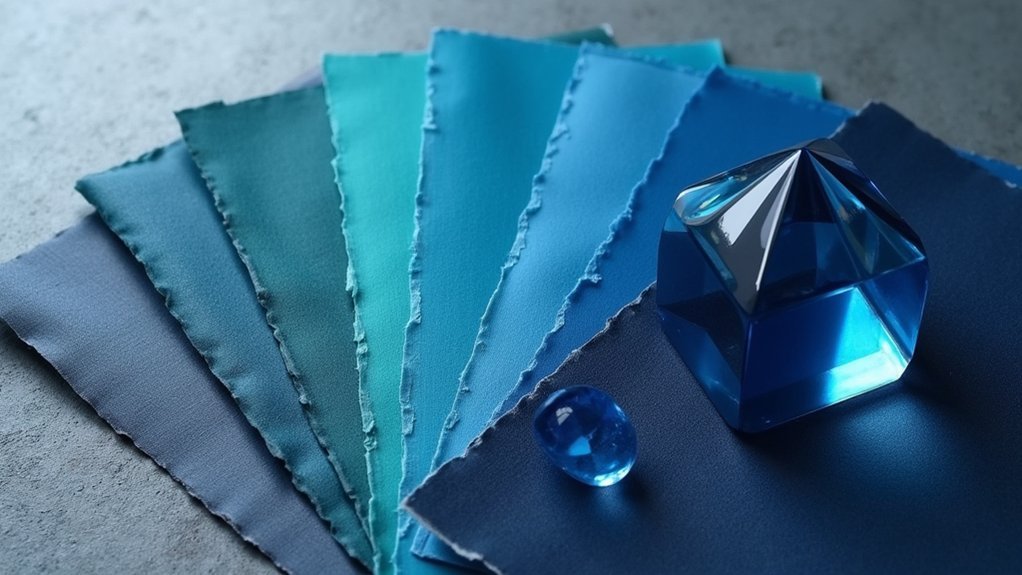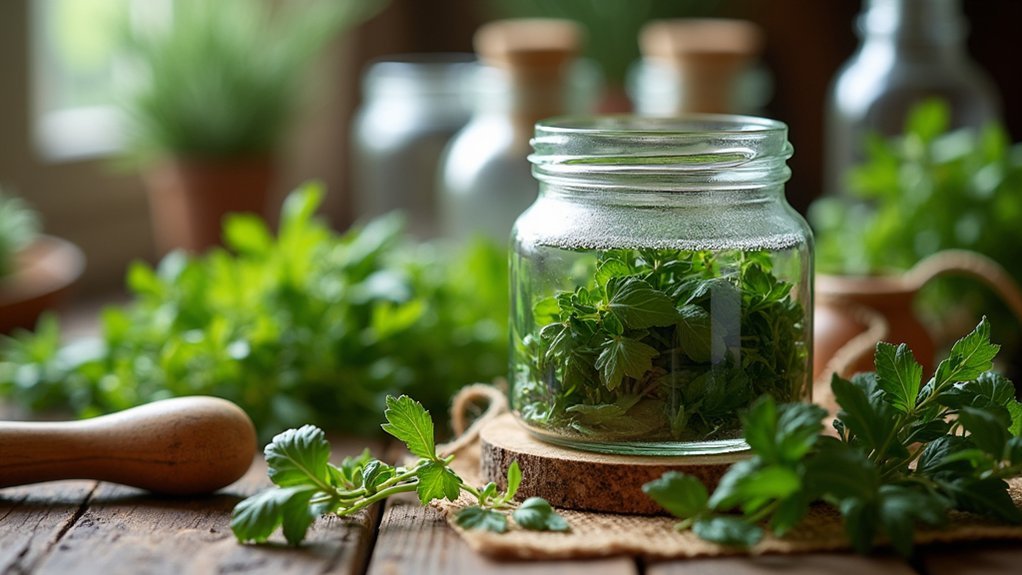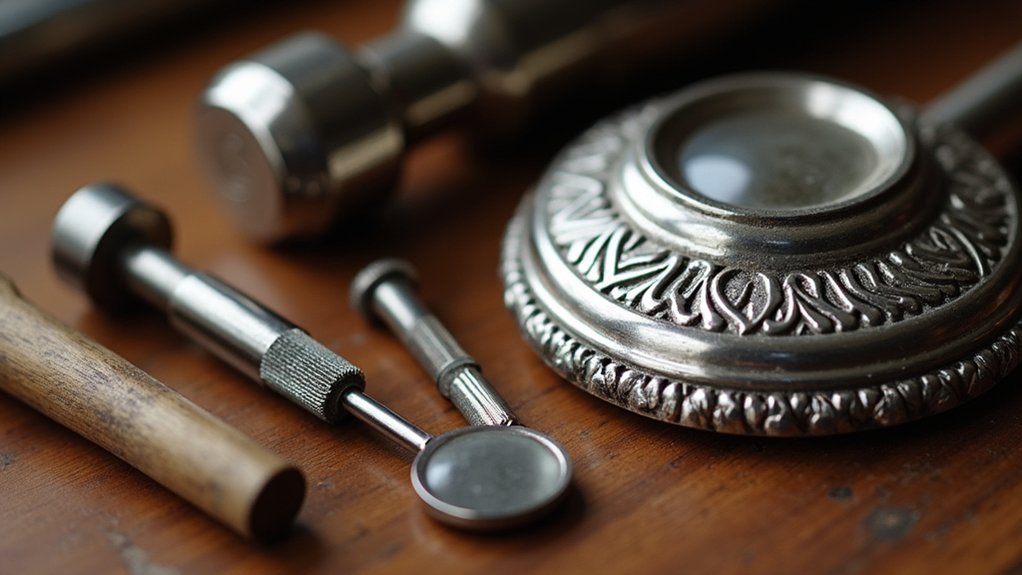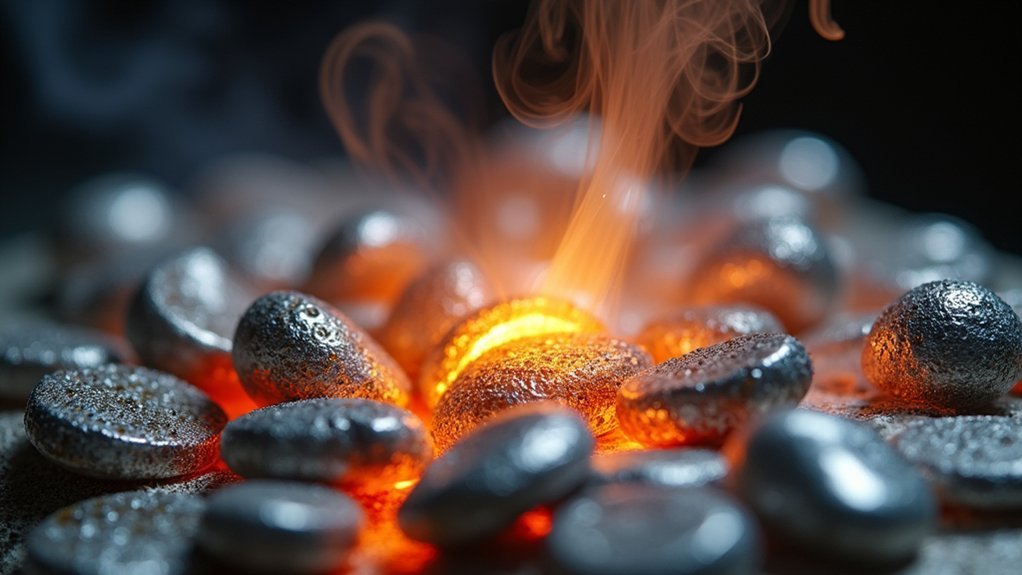Sapphire color grading evaluates hue, tone, and saturation across a spectrum beyond blue, including pink, yellow, and the rare padparadscha. While no universal system exists, gemologists use scales like GIA’s framework or the AAA to B classification. You’ll need proper lighting (ideally 5000-5500K) to assess true color qualities. Natural sapphires command higher prices than treated ones, making treatment detection essential. Understanding these nuances will help you make informed investment decisions as you explore the colorful world of sapphires.
Understanding the Sapphire Color Spectrum

While most people associate sapphires exclusively with deep blue, these precious gemstones actually span an impressive color spectrum that extends far beyond this familiar hue.
Natural sapphires come in pink, yellow, green, purple, and even unique combinations like padparadscha, which beautifully blends pink and orange tones.
When examining sapphire color grading, experts evaluate three critical components: hue (the actual color), tone (lightness or darkness), and saturation (intensity). The most valuable specimens display strong color saturation and even color distribution without gray undertones.
What gives each sapphire its distinct color? Trace elements are responsible—iron and titanium create blue sapphires, while chromium produces pink varieties.
You’ll also find rare specimens like color-change sapphires that shift hues under different lighting conditions, commanding premium prices for their uniqueness.
The Science of Hue, Tone, and Saturation in Sapphires
The elements that create a sapphire’s color are just part of understanding these remarkable gemstones.
When evaluating sapphire quality, you’ll need to take into account three critical factors that determine its appearance and value.
- Hue – This identifies the actual color, whether it’s a primary color or a combination where secondary colors appear first (like “greenish-blue” or “violet-blue”).
- Tone – Ranging from 2 (light) to 8 (very dark), tone measures how light or dark the sapphire appears.
- Saturation – The intensity of color, with levels 4-6 being most desirable; a perfect royal blue sapphire has a saturation of 5.
In color grading, sapphires with strong, pure primary colors command higher values than those with gray or brown undertones.
Professional Grading Systems and Standards

Unlike diamonds with their universally accepted 4Cs system, sapphires follow several professional grading methodologies that can sometimes puzzle consumers.
The Gemological Institute of America (GIA) offers one of the most respected sapphire grading frameworks, evaluating stones based on hue, tone, saturation, and carat weight.
Most systems classify sapphires on an AAA to B scale, with AAA representing premium quality stones.
When examining color grading reports, you’ll notice the subjective nature of assessments, as each sapphire presents unique variables that resist standardization. Saturation particularly influences a stone’s value.
Clarity grading for sapphires differs considerably from diamonds, acknowledging that inclusions are natural features.
Terms like “eye grade” (visible to naked eye) and “loupe grade” (visible under magnification) help you understand what to expect from your sapphire’s appearance.
Evaluating Blue Sapphires: The Classic Benchmark
Revered as the quintessential sapphire variety, blue sapphires establish the standard against which all other colored gemstones are measured.
When evaluating blue sapphires, you’ll need to assess their hue, tone, and saturation—with the coveted royal blue (tone grade 6, saturation level 5) commanding the highest prices. While carat weight matters, these color qualities often outweigh size in determining value.
- Color Assessment – The most valuable blue sapphires display an intense, velvety deep royal blue classified as AAA quality.
- Clarity Examination – Eye-clean (Type 1) stones with no visible inclusions are most desirable.
- Balance Consideration – A smaller, high-quality blue sapphire with perfect saturation (levels 4-6) can be worth more than a larger, inferior stone.
Fancy Sapphires: Grading Beyond Blue

Fancy sapphires dazzle collectors with their spectrum of rare hues beyond blue, including the coveted padparadscha’s pink-orange blend and color-changing varieties that shift under different lighting conditions.
You’ll find that unlike blue sapphires’ straightforward grading, these exotic gems require evaluation based on their specific color category, with factors like saturation, tone, and secondary color influences determining their market value.
When examining fancy sapphires, remember that color-change specimens command premium prices based on the completeness of their transformation and the attractiveness of both initial and final colors.
Rainbow of Rare Hues
While blue sapphires dominate popular imagination, the sapphire family actually presents a spectacular array of colors that extend far beyond the traditional royal blue.
When you’re exploring fancy sapphires, you’ll encounter extraordinary hues with distinct color grading criteria centered on hue purity and saturation intensity.
The rarest sapphire colors command premium prices in today’s growing market:
- Padparadscha sapphires, with their enchanting pink-orange blend, represent the pinnacle of rarity and demand.
- Color-change sapphires that dramatically shift hues under different lighting conditions.
- Vivid purple and green varieties that showcase exceptional saturation levels.
Unlike blue sapphires graded primarily on their royal blue depth, fancy sapphires may contain multiple primary and secondary colors that collectors increasingly appreciate for their uniqueness and diversity.
Color-Change Value Determinants
Color-change sapphires represent one of the most fascinating phenomena in gemology, surpassing even the allure of traditional blue varieties in their complexity.
When evaluating these gems, you’ll find their value hinges primarily on the strength and distinctiveness of their color alteration between different lighting conditions.
Professional grading follows similar principles as blue sapphires—assessing hue, tone, and saturation—but with heightened emphasis on the dramatic nature of the color shift.
The most valuable specimens display vibrant changes between complementary colors, such as blue to purple or green to pink.
Due to their exceptional rarity, these sapphires command premium prices, especially when exhibiting strong color change.
Remember that proper assessment requires viewing under controlled lighting, as natural and incandescent light produce distinctly different effects.
Color Zoning and Distribution Factors
When examining a sapphire’s quality, you’ll quickly discover that color zoning plays an essential role in its overall valuation.
Stones with uniform color distribution command premium market prices as they display superior visual appeal. In contrast, pronounced color zoning creates patchy appearances that considerably reduce a sapphire’s value.
During the grading process, gemologists evaluate both primary and secondary colors under controlled lighting conditions. They’re specifically looking for consistency throughout the stone’s body.
- Even distribution – Uniform coloration indicates higher quality and results in better light performance
- Subtle zoning – Minor color variations may be acceptable in larger stones
- Strategic cutting – Expert lapidaries can minimize visible zoning through precise faceting techniques
Your sapphire’s value will directly correlate with how evenly its color is distributed throughout the stone.
Lighting Conditions and Their Effect on Grading

You’ll notice dramatic differences in how your sapphire appears when viewing it under natural sunlight versus artificial lighting.
The color temperature of your light source directly impacts the perceived saturation and tone, with incandescent bulbs often warming blue sapphires while fluorescent lighting can make them appear cooler and less vibrant.
Professional graders use standardized lighting conditions to guarantee consistent evaluation, which is why your sapphire might look different in a jewelry store than it does at home.
Natural vs. Artificial Light
The difference between natural and artificial light plays an essential role in accurately grading sapphires. When you’re evaluating a sapphire’s color, natural light reveals its true hue, tone, and saturation, while artificial light sources like incandescent or fluorescent bulbs can distort these properties.
Professional gemologists utilize standardized lighting conditions to guarantee consistent color grading results.
- Daylight assessment provides the most accurate representation of a sapphire’s genuine color characteristics, highlighting subtle nuances that might otherwise go unnoticed.
- Artificial light can enhance certain color aspects while diminishing others, potentially leading to misleading evaluations.
- Color-change sapphires require examination under both lighting conditions to properly document their unique properties and guarantee accurate grading.
Color Temperature Effects
Light’s color temperature dramatically impacts how you perceive a sapphire’s color, potentially altering your entire assessment of the gemstone’s quality. Measured in Kelvin, color temperature creates distinct viewing environments that influence your grading decisions.
Lower temperatures (around 2700K) from incandescent lighting produce warmer tones, causing blue sapphires to appear more violet. Conversely, fluorescent lighting’s higher temperature amplifies cooler tones, sometimes muting the stone’s natural hue.
For accurate color grading, gemstones should be evaluated under conditions mimicking natural daylight (5000-5500K).
Professional gemologists understand these lighting conditions are essential for consistent sapphire assessment. When examining these precious gems, remember that the most authentic representation of color appears under natural daylight, revealing the true tone, saturation, and hue that determine a sapphire’s value.
Treatment Detection and Natural vs. Enhanced Color
Understanding the difference between natural and enhanced sapphires marks a significant step in your gemstone education, as treatments greatly impact both value and authenticity.
Natural sapphires command higher prices than their treated counterparts, making identification essential before purchase. You’ll need to recognize key indicators like specific inclusions and color zoning patterns that reveal a stone’s history.
Knowing a natural sapphire’s distinctive markers protects your investment, as untreated stones command premium value in the market.
- Look for silk-like needle inclusions which often indicate a natural sapphire, while unnaturally vivid colors with minimal inclusions typically suggest enhancement.
- Rely on advanced gemological techniques such as spectroscopy and microscopy to detect subtle treatment signs not visible to the naked eye.
- Always request proper certification from reputable laboratories that specifically addresses treatment status and natural origin verification.
Frequently Asked Questions
What Is the Grading Scale for Sapphires?
Sapphires are graded from A to AAAA, with evaluation based on hue (color), tone (lightness/darkness), saturation (intensity), and carat weight. You’ll find AAA and AAAA representing the highest quality sapphires.
What Is the Most Sought After Sapphire Color?
You’ll find that the most sought-after sapphire color is the intense, velvety deep royal blue (AAA quality). This rich hue commands the highest prices, making it the premier choice for fine jewelry collectors.
What Is the Most Desirable Color of Sapphire?
The most desirable sapphire color is an intense, velvety deep royal blue (AAA quality). You’ll find this rich blue hue, with minimal gray undertones and strong saturation, commands the highest prices in the market.
Should Sapphire Be Darker or Lighter?
You’ll want a medium-toned sapphire rather than extremely dark or light. Very dark stones (tone 8) appear opaque, while overly light ones lack saturation. The ideal balance shows vibrant color while maintaining transparency.
In Summary
You’ve now mastered the essentials of sapphire color grading. Whether you’re evaluating blue classics or fancy varieties, you’ll need to contemplate hue, tone, saturation, distribution, and lighting conditions. Remember that proper grading requires recognizing treatments and understanding market standards. With this knowledge, you’re better equipped to appreciate, value, and select these remarkable gemstones with confidence and expertise.





Leave a Reply